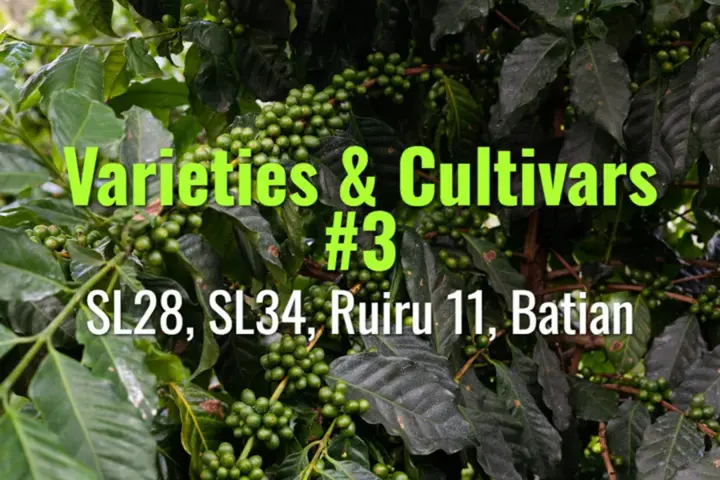SL28, SL34, Ruiru 11, Batian
This topic explores the key Kenyan-developed coffee varieties—SL28, SL34, Ruiru 11, and Batian—their origins, traits, flavor profiles, and significance for disease resistance and quality.
- Coffee Basics Nerds
- 2 min read
Article 3 of 12 in Varieties & Cultivars/

Background: Kenya’s Breeding Legacy
- Kenya’s Scott Agricultural Laboratories (SL) and later the Coffee Research Institute developed several important varieties in response to coffee leaf rust, berry disease, and the demand for high cup quality.
SL28
- Origin: Selected in the 1930s from Tanganyika (now Tanzania).
- Traits: Drought-tolerant, tall tree, adaptable to diverse environments.
- Flavor profile: Bright acidity, citrus, blackcurrant notes; highly prized in specialty markets.
- Weakness: Susceptible to leaf rust and coffee berry disease (CBD).
SL34
- Origin: Selected in Kenya, related to Bourbon/Typica heritage.
- Traits: Tolerates heavy rainfall and diverse soils; tall, vigorous growth.
- Flavor profile: Balanced body, sweet fruit, excellent complexity.
- Weakness: Similar disease susceptibility as SL28.
Ruiru 11
- Origin: Developed in Kenya, released in 1985. Hybrid cross of SL varieties with Catimor and other resistant lines.
- Traits: Compact/dwarf size (like Caturra), high yield, resistant to CBD and leaf rust.
- Flavor profile: Good quality but can lack the complexity of SL28/SL34; varies by management.
- Advantage: Suited for intensive planting and smallholder farms.
Batian
- Origin: Released in 2010, bred by the Coffee Research Institute (Kenya). Named after Mount Kenya’s highest peak.
- Traits: Tall variety, high yield, early maturing (produces in year 2 instead of year 3–4).
- Disease resistance: Resistant to CBD and rust.
- Flavor profile: Cup quality closer to SL28/SL34, but with resilience.
Comparative Summary
- SL28: Exceptional flavor, drought tolerance, low disease resistance.
- SL34: Great flavor, rain tolerance, low disease resistance.
- Ruiru 11: Disease-resistant, compact, high yield, moderate flavor complexity.
- Batian: Resistant, early bearing, good flavor, balance of resilience and quality.
Lasting Importance
- SL28 and SL34 shaped Kenya’s global reputation for high-quality coffee.
- Ruiru 11 and Batian represent modern breeding solutions to climate and disease challenges.
- Together, these varieties reflect the balance between heritage quality and genetic resilience needed for the future of coffee cultivation.
You might also like:
- Tags:
- Lasting Importance
- Cup Quality
- Flavor Profile
- High Quality
- Specialty Markets
- Flavor Balance
- Disease Resistance
- Flavor Complexity
- Leaf Rust
- Coffee Leaf
- Quality Coffee
- Bright Acidity
- Coffee Cultivation
- High Yield
- Coffee Research
- Coffee Berry
- Quality Lasting
- Future Coffee
- Disease Resistant
- Rust Coffee
- Acidity Citrus